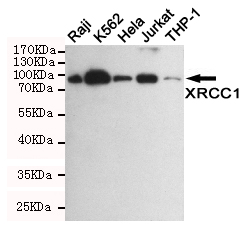- Home
- About
- Promotions
-
Products
-
Elisa Kits
- |
-
Primary antibodies
- |
-
Secondary antibodies
- |
-
Proteins
- |
-
IHC reagents
- |
-
WB reagents
- PonceauS Staining Solution
- PBST Washing Buffer, 10X
- 1.5M Tris-HCl Buffer, pH8.8
- 1M Tris-HCl Buffer, pH6.8
- 10% SDS Solution
- Prestained Protein Marker
- TBST Washing Buffer, 10X
- SDS PAGE Loading Buffer, 5X
- Stripping Buffered Solution
- Tris Buffer, pH7.4, 10X
- Total Protein Extraction Kit
- Running Buffer, 10X
- Transfer Buffer, 10X
- 30% Acr-Bis(29:1) Solution
- Tris电泳液速溶颗粒
- PBS(1X, premixed powder)
- TBS(1X, premixed powder)
- 快速封闭液
- 转膜液速溶颗粒
- Chemical reagents
- News
- Distributor
- Resources
- Contact
- Home
- >
- Info
- >
- XRCC1 mouse mAb
- >
- Go Back
XRCC1 mouse mAb
- Catalog No.:YM1417
- Applications:WB
- Reactivity:Human
- Fields:
- >>Base excision repair
- Immunogen:
- Purified recombinant human XRCC1 protein fragments expressed in E.coli.
- Specificity:
- This antibody detects endogenous levels of XRCC1 and does not cross-react with related proteins.
- Formulation:
- Liquid in PBS containing 50% glycerol, 0.5% BSA and 0.02% sodium azide.
- Source:
- Monoclonal, Mouse
- Dilution:
- wb dilution 1:1000
- Purification:
- The antibody was affinity-purified from mouse ascites by affinity-chromatography using epitope-specific immunogen.
- Storage Stability:
- -15°C to -25°C/1 year(Do not lower than -25°C)
- Other Name:
- DNA repair protein XRCC1;RCC;X ray repair complementing defective repair in chinese hamster;X ray repair complementing defective repair in chinese hamster cells 1;X ray Repair Complementing Defective Repair in Chinese Hamster Cells;X ray repair cross complementing protein 1;X ray repair, complementing defective, repair in Chinese hamster;X-ray repair cross-complementing protein 1;XRCC 1;Xrcc1;XRCC1_HUMAN.
- Background:
- The protein encoded by this gene is involved in the efficient repair of DNA single-strand breaks formed by exposure to ionizing radiation and alkylating agents. This protein interacts with DNA ligase III, polymerase beta and poly (ADP-ribose) polymerase to participate in the base excision repair pathway. It may play a role in DNA processing during meiogenesis and recombination in germ cells. A rare microsatellite polymorphism in this gene is associated with cancer in patients of varying radiosensitivity. [provided by RefSeq, Jul 2008],
- Function:
- function:Corrects defective DNA strand-break repair and sister chromatid exchange following treatment with ionizing radiation and alkylating agents.,polymorphism:Carriers of the polymorphic Gln-399 allele may be at greater risk for tobacco- and age-related DNA damage.,PTM:Phosphorylation of Ser-371 causes dimer dissociation. Phosphorylation by CK2 promotes interaction with APTX and APLF.,PTM:Sumoylated.,similarity:Contains 2 BRCT domains.,subcellular location:Accumulates at sites of DNA damage.,subunit:Homodimer. Interacts with polynucleotide kinase (PNK), DNA polymerase-beta (POLB) and DNA ligase III (LIG3). Interacts with APTX and APLF.,
- Subcellular Location:
- Nucleus . Moves from the nucleoli to the global nuclear chromatin upon DNA damage. .
- Expression:
- Expressed in fibroblasts, retinal pigmented epithelial cells and lymphoblastoid cells (at protein level).

- Western blot detection of XRCC1 in Raji,K562,Hela,Jurkat and THP-1 cell lysates using XRCC1 mouse mAb (1:1000 diluted).Predicted band size:82KDa.Observed band size:82KDa.



